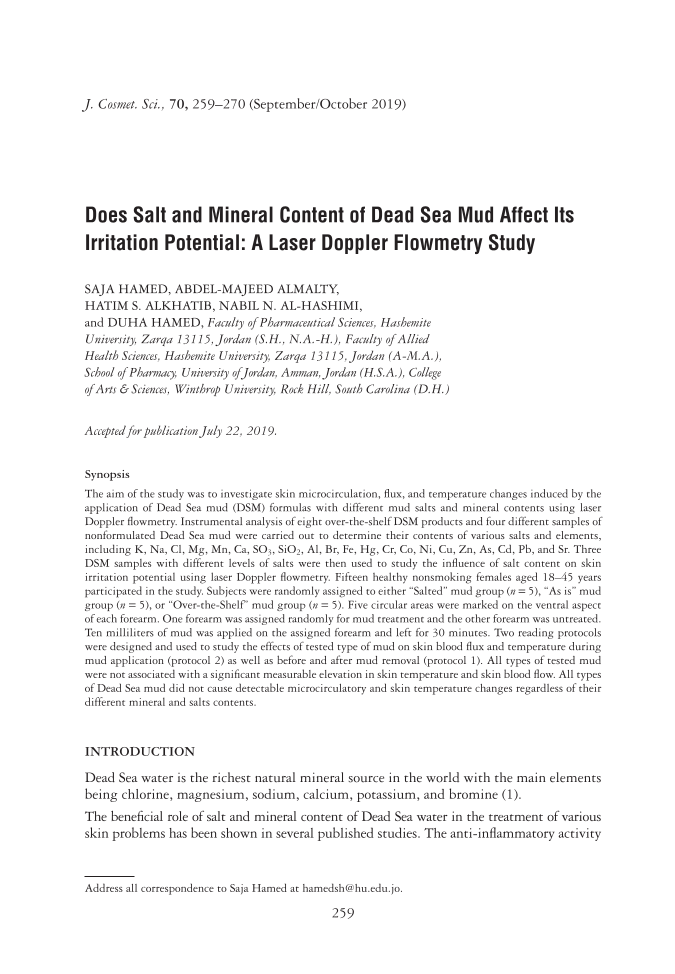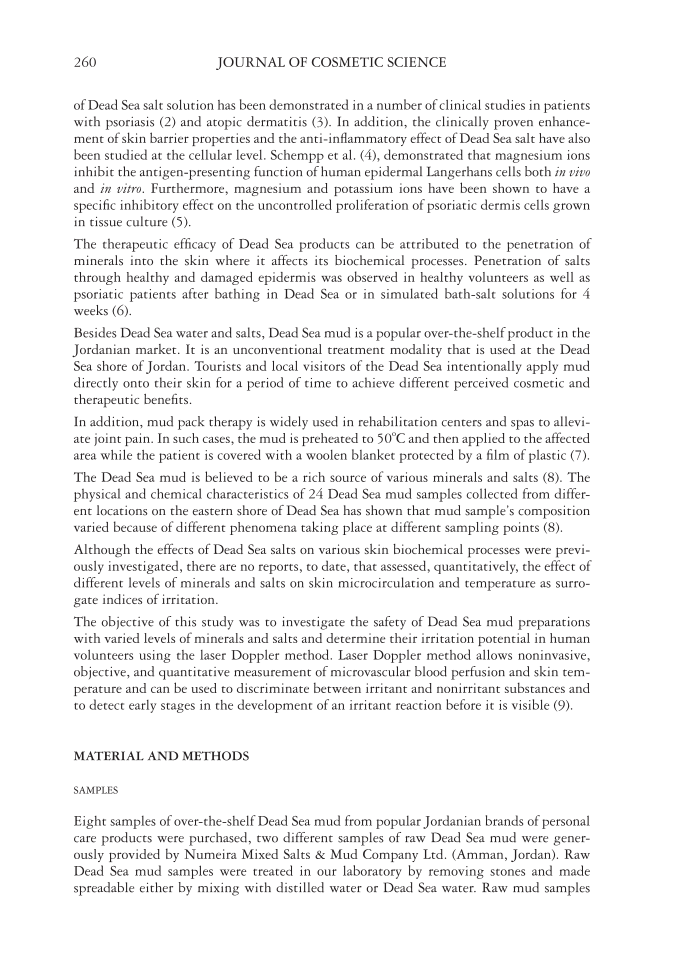J. Cosmet. Sci., 70, 259–270 (September/October 2019) 259 Does Salt and Mineral Content of Dead Sea Mud Affect Its Irritation Potential: A Laser Doppler Flowmetry Study SAJA HAMED, ABDEL-MAJEED ALMALTY, HATIM S. ALKHATIB, NABIL N. AL-HASHIMI, and DUHA HAMED , Faculty of Pharmaceutical Sciences, Hashemite University, Zarqa 13115, Jordan (S.H., N.A.-H.), Faculty of Allied Health Sciences, Hashemite University, Zarqa 13115, Jordan (A-M.A.), School of Pharmacy, University of Jordan, Amman, Jordan (H.S.A.), College of Arts & Sciences, Winthrop University, Rock Hill, South Carolina (D.H.) Accepted for publication July 22, 2019 . Synopsis The aim of the study was to investigate skin microcirculation, fl ux, and temperature changes induced by the application of Dead Sea mud (DSM) formulas with different mud salts and mineral contents using laser Doppler fl owmetry. Instrumental analysis of eight over-the-shelf DSM products and four different samples of nonformulated Dead Sea mud were carried out to determine their contents of various salts and elements, including K, Na, Cl, Mg, Mn, Ca, SO3, SiO2, Al, Br, Fe, Hg, Cr, Co, Ni, Cu, Zn, As, Cd, Pb, and Sr. Three DSM samples with different levels of salts were then used to study the infl uence of salt content on skin irritation potential using laser Doppler fl owmetry. Fifteen healthy nonsmoking females aged 18–45 years participated in the study. Subjects were randomly assigned to either “Salted” mud group (n = 5), “As is” mud group (n = 5), or “Over-the-Shelf” mud group (n = 5). Five circular areas were marked on the ventral aspect of each forearm. One forearm was assigned randomly for mud treatment and the other forearm was untreated. Ten milliliters of mud was applied on the assigned forearm and left for 30 minutes. Two reading protocols were designed and used to study the effects of tested type of mud on skin blood fl ux and temperature during mud application (protocol 2) as well as before and after mud removal (protocol 1). All types of tested mud were not associated with a signifi cant measurable elevation in skin temperature and skin blood fl ow. All types of Dead Sea mud did not cause detectable microcirculatory and skin temperature changes regardless of their different mineral and salts contents. INTRODUCTION Dead Sea water is the richest natural mineral source in the world with the main elements being chlorine, magnesium, sodium, calcium, potassium, and bromine (1). The benefi cial role of salt and mineral content of Dead Sea water in the treatment of various skin problems has been shown in several published studies. The anti-infl ammatory activity Address all correspondence to Saja Hamed at hamedsh@hu.edu.jo.
JOURNAL OF COSMETIC SCIENCE 260 of Dead Sea salt solution has been demonstrated in a number of clinical studies in patients with psoriasis (2) and atopic dermatitis (3). In addition, the clinically proven enhance- ment of skin barrier properties and the anti-infl ammatory effect of Dead Sea salt have also been studied at the cellular level. Schempp et al. (4), demonstrated that magnesium ions inhibit the antigen-presenting function of human epidermal Langerhans cells both in vivo and in vitro. Furthermore, magnesium and potassium ions have been shown to have a specifi c inhibitory effect on the uncontrolled proliferation of psoriatic dermis cells grown in tissue culture (5). The therapeutic effi cacy of Dead Sea products can be attributed to the penetration of minerals into the skin where it affects its biochemical processes. Penetration of salts through healthy and damaged epidermis was observed in healthy volunteers as well as psoriatic patients after bathing in Dead Sea or in simulated bath-salt solutions for 4 weeks (6). Besides Dead Sea water and salts, Dead Sea mud is a popular over-the-shelf product in the Jordanian market. It is an unconventional treatment modality that is used at the Dead Sea shore of Jordan. Tourists and local visitors of the Dead Sea intentionally apply mud directly onto their skin for a period of time to achieve different perceived cosmetic and therapeutic benefi ts. In addition, mud pack therapy is widely used in rehabilitation centers and spas to allevi- ate joint pain. In such cases, the mud is preheated to 50oC and then applied to the affected area while the patient is covered with a woolen blanket protected by a fi lm of plastic (7). The Dead Sea mud is believed to be a rich source of various minerals and salts (8). The physical and chemical characteristics of 24 Dead Sea mud samples collected from differ- ent locations on the eastern shore of Dead Sea has shown that mud sample’s composition varied because of different phenomena taking place at different sampling points (8). Although the effects of Dead Sea salts on various skin biochemical processes were previ- ously investigated, there are no reports, to date, that assessed, quantitatively, the effect of different levels of minerals and salts on skin microcirculation and temperature as surro- gate indices of irritation. The objective of this study was to investigate the safety of Dead Sea mud preparations with varied levels of minerals and salts and determine their irritation potential in human volunteers using the laser Doppler method. Laser Doppler method allows noninvasive, objective, and quantitative measurement of microvascular blood perfusion and skin tem- perature and can be used to discriminate between irritant and nonirritant substances and to detect early stages in the development of an irritant reaction before it is visible (9). MATERIAL AND METHODS SAMPLES Eight samples of over-the-shelf Dead Sea mud from popular Jordanian brands of personal care products were purchased, two different samples of raw Dead Sea mud were gener- ously provided by Numeira Mixed Salts & Mud Company Ltd. (Amman, Jordan). Raw Dead Sea mud samples were treated in our laboratory by removing stones and made spreadable either by mixing with distilled water or Dead Sea water. Raw mud samples
Purchased for the exclusive use of nofirst nolast (unknown) From: SCC Media Library & Resource Center (library.scconline.org)


















































